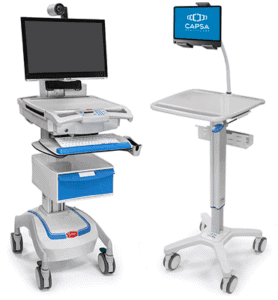
By Steve Torbett, Senior Product Manager, Capsa Healthcare
Mobile computer carts (or WOWs-workstations on wheels) in healthcare settings are becoming more robust, lightweight, and simple to use. Their streamlined design is topped only by their adaptability. Mobile workstations help caregivers save critical steps by carrying what they need most often to deliver patient care. They also are designed for clinicians to easily access EMR, or electronic medical records. A mobile computer cart that is well designed helps caregivers make better patient care decisions and avoid errors. And there are many developments to come. This blog is about the present and future potential for these versatile point-of-care workstations.
The COVID-19 response has amplified the application of telemedicine carts with advanced communication and video capabilities. Telehealth expansion to connect patients in hospitals and senior living facilities with their families and outside care providers, for instance, is far-reaching; the Centers for Medicare and Medicaid Services have been expanding reimbursement rules for telehealth services. Workstations can include dual monitors and a wide assortment of specialized, plugged-in scopes to examine a patient’s throat, ears, skin, and eyes.

Additional specialty cart models include fetal monitoring carts; phlebotomy carts to draw blood and take samples back to the lab; patient registration carts to hold document scanners, label printers, signature pads and tools to admit a patient to the hospital; training carts with dual displays, where one monitor spins around so the class can watch, while the instructor is typing.
Battery power is helping the rapid expansion of mobile computing. The newest lithium batteries are highly evolved from the pain-points we remember from just five or 10 years ago. Old models used sealed lead-acid batteries (essentially like a car battery). There is an increasing number of lightweight LED monitors and tablets being used instead of heavier devices. Early on there were wireless coverage and strength of signal issues, but facilities now have more access points and better connectivity.
It can be difficult for hospital I.T. teams to manage a fleet of point-of-care workstations spread out across their facilities’ campuses. Many hospitals have to manage carts at remote locations where there is no tech support onsite. Meeting those challenges required the evolution of remote fleet management software. This software provides to-the-minute data on cart location (essentially like GPS), battery life, availability, and user data. It helps the I.T. department make smart decisions and to be proactive. Without fleet management software providing real-time data, I.T. may be forced to buy more carts, which adds further cost, more devices to manage, and out-of-service cart frustrations.
We are always asking open-ended questions of our users to hear their challenges and needs. That includes clinicians and doctors, IT and facility administrators. Asking questions the right way frequently helps Capsa uncover needs that lead to product improvements or innovations. We recently updated our CareLink carts directly as a result of nurse feedback. We simply asked, “What belongs on a screen if it were embedded in the computing cart?” And “How would you use your smartphone in patient care?” Asking these questions led to several features being developed in our CareLink line. That was powerful.
Most experts project an increasing use of handheld devices. By that, I mean de-coupling the computing and the computer from being attached to keyboards, displays, other devices and the storage they control. We also see trends to small, light-duty carts for more basic uses. Here is an example: a physician-rounding cart that healthcare providers use to make their rounds in a hospital. We may also see a system of devices and carts that work together, instead of forcing a single one-size-fits-all for every task.
One thing is certain in this rapidly changing landscape: Capsa will continue to evolve and develop new and innovative mobile computing solutions, in-step with our customers’ changing needs.
You can also read a version of this blog in HealthTech Magazine.